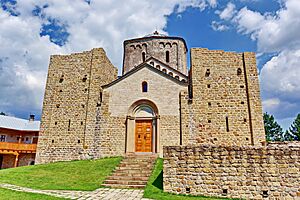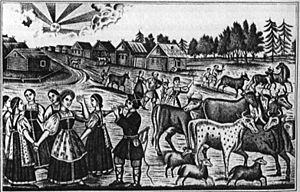George's Day in Spring facts for kids
Quick facts for kids Saint George's DaySaint George's Day in Spring |
|
|---|---|
Icon of Saint George
|
|
| Date | 6 May |
| Next time | 6 May 2026 |
| Frequency | annual |
| Related to | Saint George's Day, and George's Day in Autumn |
Saint George's Day in Spring, also known as Đurđevdan (Serbian: Ђурђевдан; Bulgarian: Гергьовден, romanized: Gergovden; Macedonian: Ѓурѓовден, romanized: Ǵurǵovden), is an important religious holiday in many Slavic countries. It celebrates Saint George, a very important saint in the Eastern Orthodox Church. This special day is usually celebrated on May 6th each year.
Saint George is known as a brave military saint, especially in Slavic, Georgian, and Circassian traditions. He is often shown in pictures (called icons) riding a horse and fighting a dragon. This image shows him as a hero who stood up for his beliefs. Beyond its religious meaning, Saint George's Day is also a popular spring festival in the Balkans, celebrating the return of warmer weather and new life.
Contents
Celebrating Saint George's Day in the Balkans
In countries like Serbia, Bulgaria, and North Macedonia, Saint George's Day is a big celebration. In Serbia, it's called Đurđevdan, and it's celebrated on May 6th. For many Serb families, it's also a slava, which is a special family celebration for their patron saint.
This holiday is also very important for Romani communities in the Balkans, whether they are Orthodox or Muslim. They call it by names like Ederlezi or Herdeljez, which come from the Turkish word Hıdırellez.
Traditions and Festivities
The celebrations for Saint George's Day are often linked to the story of Saint George, the brave knight who saved a maiden from a dragon. But it's also a time to welcome spring and the awakening of nature. Many traditions come from older customs that celebrate the earth becoming green again.
Some common activities include:
- Decorating: People often decorate their homes and gates with fresh green branches and colorful flowers.
- Water Rituals: Many people take ritual baths in rivers or springs, or wash their faces with water that has flowers in it. This is believed to bring good health.
- Feasting: A big part of the celebration is sharing a meal, often including a roasted lamb.
- Music and Dance: Especially for the Romani people, music, dancing, and performances by traditional brass bands are very important.
Serbia's Celebrations
In Serbia, about one-third of the population celebrates Saint George as their family's patron saint. This means they have a special family feast called a krsna slava. A popular tradition on the evening before Saint George's Day is to decorate homes with green plants and flowers. Children might wash their faces in water with roses and green leaves, wishing for good health.
Historically, this day was important for Serbian fighters called hajduks. They would gather and plan their actions in nature, often in forests, before fighting until late autumn. This is why spending the day outdoors is still a common custom. Some areas also have festivals with traditional dances and local food.
Bulgaria's and Macedonia's Customs
In Bulgaria, May 6th is not only Saint George's Day but also the Day of the Bulgarian Army, celebrated with a military parade. Saint George is seen as the protector of spring plants, farmers, and shepherds. People perform cattle rituals, sometimes sacrificing a lamb for the saint. Villagers also do a traditional chain dance called Horo and drink water from springs for good health.
In Macedonia, picking herbs on the eve or morning of Saint George's Day is a key tradition. Some believe these herbs have magical powers. The Macedonian customs focus on celebrating nature, new plant growth, and life in general. People also visit holy places dedicated to Saint George.
Croatian and Bosnian Traditions
In Croatia, the holiday is called Jurjevo and is celebrated on April 23rd by Roman Catholic Croats, especially in rural areas. They sometimes light bonfires, similar to other spring festivals. In some parts of Croatia, five girls are chosen to dress as Dodola goddesses (from Slavic mythology) in leaves and sing for the village.
In Bosnia, many people from different religious groups used to celebrate each other's holidays. So, even though Ðurđevdan is an Orthodox holiday, many Muslims in Bosnia also celebrated it, calling it Jurjev. This shows how widely loved the holiday was across different communities.
"Ðurđevdan" is also the name of a very famous song by the band Bijelo dugme. It's based on a traditional Romani folk song called "Ederlezi".
Saint George's Day in Eastern Slavic Countries
In Russia, Saint George's Day is known as Yuri's Day of Spring (Russian: Юрьев день весенний, romanized: Yuryev den vesenniy). The Russian Orthodox Church celebrates Saint George on April 23rd (which is May 6th on the Western calendar).
There's also another "Yuri's Day" in Russia, celebrated on December 9th. This day remembers the opening of a church dedicated to Saint George in Kiev a long time ago. Because one of the Russian names for George is Yuri, these two holidays are known as "Yuri's Day in the Spring" and "Yuri's Day in Autumn".
See also
 In Spanish: Día de Yuri para niños
In Spanish: Día de Yuri para niños



